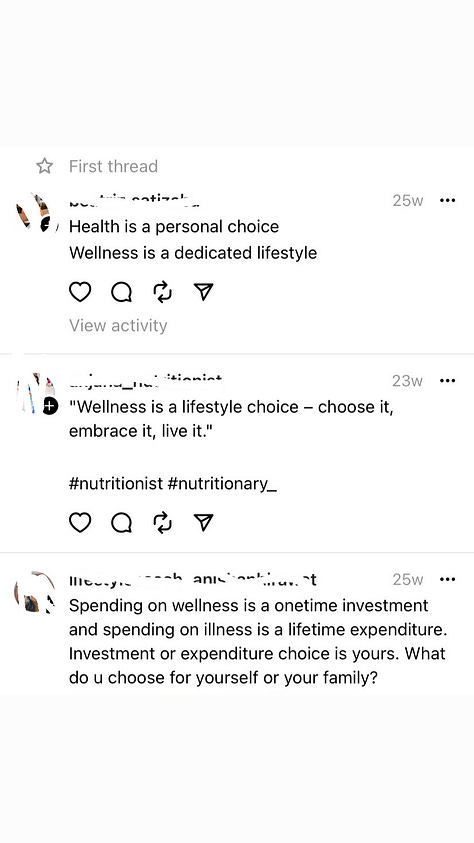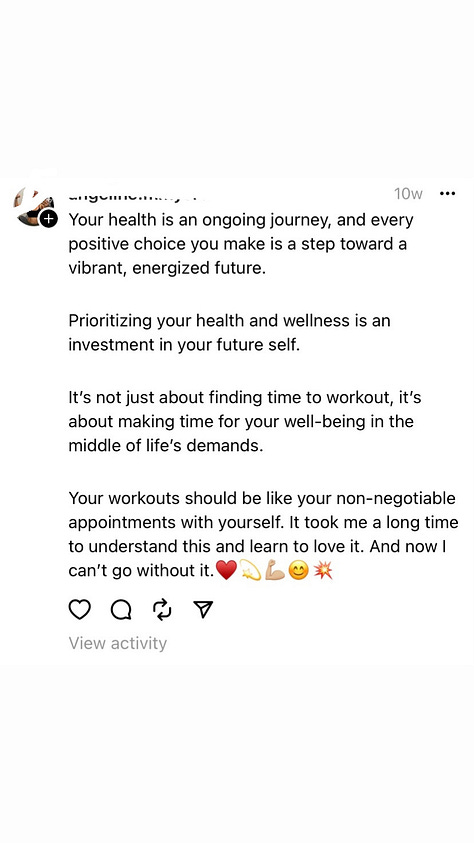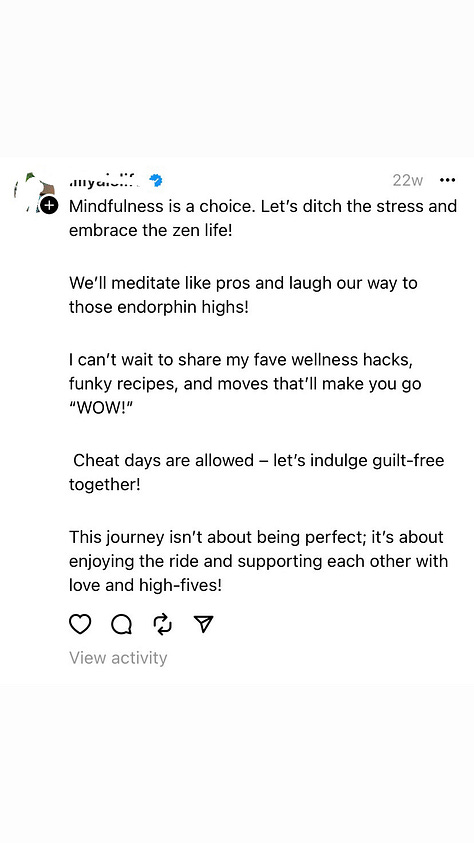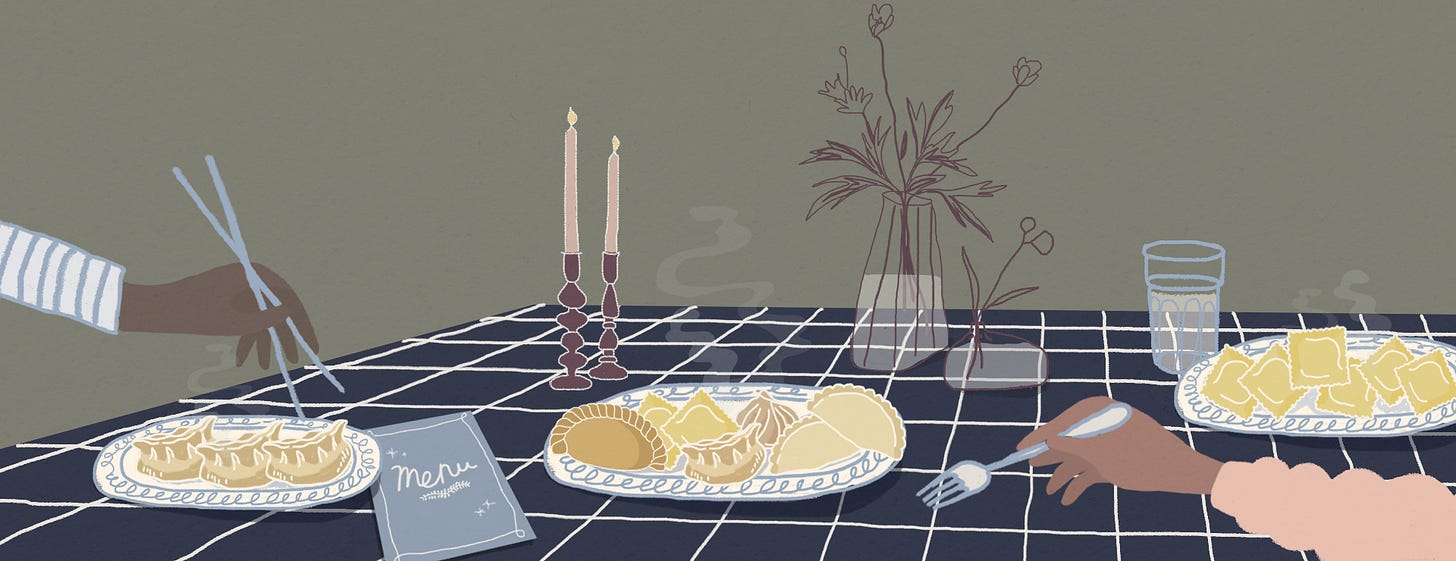I started using Threads last fall and found (at least in the beginning) that it was a nice space. The algorithm was a bit better at bringing like-minded together, and many that fled Twitter found a place to be themselves again. And then swiftly (though perhaps not entirely disconnected from X’s recent and large outage), the “For You” default homepage morphed, becoming rife with long-haired white women posting endless scrolls about how health was a choice (see below). Or that wellness, even in the absence of health, was a choice, as though you could find reprieve from your ailments if you only chose better for yourself.



Wellness is certainly not, and never has been, a personal choice. It is particularly not a personal choice amidst the social, political, and environmental structures we find ourselves entering in 2024. And to suggest otherwise is in poor taste during the genocide of Palestinians, or the displacement and silent genocide of over 7 million in the Congo. The statistics surrounding how much disease, disability, and death have stemmed from the ongoing Israeli strikes against Gaza are staggering and nearly incomprehensible. Imani Barbarin (of @crutches_and_spice) has been instrumental in my understanding of how Palestinians become disabled through the ongoing attacks in Gaza, and how there is no infrastructure, medical supplies, or support for this.
While these genocides and forcible displacements are choices, they are not the choices of individuals, but rather that of the collective global political powers that have forced death, disease, and disability through colonial violence.
Yet here in Canada, amidst the global grief and violence, we are in our darker months. The focus of the new year refreshes the interest toward our personal choices around health, wellbeing, resolutions, In/Out lists, and goal setting for the fresh calendar year. Particularly this year, I think there’s an importance in examining the tone that wellness discourses have taken over the last half-decade.
Wellness culture is old, but the nexus of social media and health authoritarianism have cemented the new shapes of measuring wellbeing for the 21st century. I wanted today to take a deeper look into why there is so much more power in wellness online, and what the “health as choice” discourse represents in the broader landscape of war, election years, and nation-state power.
spiritual self-optimization and biocitizenship
Wellness is something I speak a lot about, mostly against. It is a fascination of mine in how it can have so many layered and distinct meanings. I’ve spent nearly 8 years working with Indigenous Nations in Canadian environmental contexts (an example can be found here), where the idea of wellness is varied by Indigenous culture, but generally more holistic and rooted to land, language, and community. I sometimes wonder if that’s what we’re trying to do with capitalist wellness culture. Though as per usual, we didn’t quite stick the landing in our appropriation of Indigenous health frameworks.
The 21st century rendition of wellness constructs are extraordinarily white, with content creators self-defining as experts on the elements of a life well-lived: nutrition, lifestyle, exercise, and new age spiritual balances. Ingram (2020) identified the root of wellness culture as the 1960s and 70s counter-culture of California, where the ideals of freedom, equality, and experimentation were braided together around health. Within counterculture wellness ideals there were important politics of racial, class, gender, and sexuality access to medical care being used to fight for alternatives and better health systems.
In 1959, wellness understood to include emotional, physical, spiritual growth, and holistic approaches for the “full potential” of oneself. While this certainly does pull from Indigenous health frameworks, it also sets the stage for the corporate optimization of health we see now. To me, the connection between the counter-culture freedoms for alternative health and the mainstream emphasis on wellness as full potential have always coalesced in how wellness gets applied in contemporary Western contexts.
With the current influencer-driven iteration, these sociocultural dynamics that are integral to health outcomes are nearly wiped from the board. The full potential of a person is largely limited to their body, once again, despite advocating for freedom from biomedical approaches that treat the symptom rather than the totality.
I’ve spoken before about my love of Charlotte Palermino (who now has a Substack!
) and how she speaks to the millennial ability to optimize lifestyle in ways previous generations could not. The pursuit of modern wellness is an extension of the more general pursuit of optimization. The 1950s discussions on “peak well-ness” emphasize human potential, and set the pathway for later New Age spiritualities to emphasize spiritual awakenings self-actualization (despite the latter forever reminding me of the Princess Diaries books instead of The Four Agreements).Stephanie Baker speaks to the strategies and themes that alternative health influencers used throughout COVID (who she understands as the conspiratorial cousin of wellness influencers). Baker identifies the use of codes to attract new followers of a specific moral matrix around health, arguing that that these codes allow for personal journeys of transformation and self-improvement. Alternative health influencers also position the body, one’s intuition, and capital-N-nature as superior to medical expertise. This often translates as needing to cleanse one’s body from impurities of the modern age, such as toxins, GMOs, and other unclean entities (sadly, not Crocs).
wellness symbology and colonial pre-occupations
I find this part interesting as someone who grew up Irish Catholic, having escaped the language of impure sinner the moment I got out of high school. Catholicism was an important lesson to me in how these codes or symbols of purity persist in wellness movements as well. Symbolism is deeply needed within religious followings, as are metaphors, analogies, and other comparative devices. Within the community-building wellness movements, Nature and the physical human body at peak health are understood to be of a higher caliber of morality and power, ultimately positioned as superior.
What strikes me most amidst all of this is just how many decades of artificial Cartesian dualisms have maintained the superiority of the mind over the body, and the malleability of landscape as resource to extract by the superior societal structures in place in Western society. The separation of mind and body strategically places the body as a legitimate object within the domain of science, and the mind in the domain of theology. But from that thinking still rises the biological and moral superiority of “natural, healthy” bodies within wellness movements of purity.
I wonder, perhaps, if this current dismissal of centuries-old colonial pre-occupation with mind before body and society before nature, is now working because of how the colonial nation-state mythologies have sterilized the understanding of land and body. I think that through the violent extraction of land as a resource, it becomes okay to connect to land again now that it is newly coded by value. There are areas where the land must be maintained to suction up oil and gas and wood and agriculture, and there are areas we have fortressed as places to protect and visit (such as national parks).
In any case, these newly sterilized landscapes, this new Nature, this highly specific form of bodily sovereignty within wellness culture, is all positioned to inform and maintain the concept of a good, virtuous biocitizen.
a sick and deviant majority
Through the moral authority self-exercised in wellness influencers, there is healthy distance made from institutional and biomedical healthcare. Expansive categories of health through biomedical systems have restricted what is considered “healthy and normal” in a way that Nancy Scheper-Hughes and Margaret Lock argued in 1987 created “a sick and deviant majority” population. In doing so, health was constructed as a self-project, where individuals “should take responsibility for their health and place the pursuit of healthy lifestyles at the centre of moral virtue, personhood, and citizenship” (from Musolino et al. 2015).
Susan Greenhalgh uses the concept of the biocitizen the capture the complicated nature of these morally-driven wellness pursuits. The biocitizen in her work represents an individual who devotes considerable time and effort toward diet and exercise to maintain body ideals of an era (or what would be deemed a medically “normal” weight in today’s healthcare settings). These individuals not only take on their bodies as a health project, but take the responsibility for others in their social environments to also become good biocitizens. The pure, toxin-free version of puff-puff-pass.
Belonging can be tremendously affected by someone’s ability to maintain their biocitizenship criteria within these movements. This positions their relationships with their bodies as a reflection of individual success or failure, as well as more broadly representing their alignment with specific social and cultural identities. If you are a fastidious 12-3-30 treadmill girl, does your body and aesthetic align with the other TikTok users that practice this? Does your Stanley water bottle make a cameo in your videos? And how does that make you think about belonging, water intake, and exercise as practice?
Stephanie Baker and Chris Rojek argued in their 2019 book Lifestyle Gurus: Constructing Authority and Influence Online that personal responsibility is extended in wellness culture to reflect the “choice” to make “the decisive act to reset their lives through a conscious reversal of poor diet and lifestyle, and negative thinking. The symbolic equation of foods as pure and toxic (such as organic apples compared to GMO apples) not only emphasizes the morality of reaching your peak well-being but shows that it can be weaponized to spread further beliefs around spiritual and ethnic superiority. And that is where it starts to get scary.
no place for social determinants of health
While American and Canadian politicians (and Canadian CEOs, such as Heather Reisman of Indigo) are providing arms provisions funding for the Israeli military, seeing wellness influencers touting that “wellness is a choice” seems almost maniacal. I often wonder if these influencers ever make the connections between these realms of war and wellness, but I certainly see it as an insidious and looming danger.
Because wellness culture is so good at maintaining moral superiority, and by subliminal extension, racial superiority, it flattens the reality of healthcare access for the global majority. Social determinants of health aren’t ignored in Canada anymore (though I’d argue seriously downplayed), but are made up of the non-medical elements of life that can shape health. These include what someone is born into, without choice, such as where one is lives (and the geography of environmental racism), where one works (and the risks of health exposures from long-term work), and how they are able to access food, housing, childcare, income, and so much more.
To assume that everyone has the luxury of choice across their lives comes from a position of privilege. I like to mentally replace the use of “personal choice” in wellness influencer-speak to “having money” to help reset my brain. Try it: “Wellness comes as a result of personal choice” can easily and more accurately be changed to “Wellness comes as a result of having money.”
It is not ever as easy as suggesting that someone can simply improve their health outcomes by going to seek out healthcare or eating a niche fad diet. While someone that has money may do these simply, health will look different for those who cannot. In some circumstances, someone may be able to safely access a culturally appropriate healthcare provider but may not be able to access foods with the vitamins and nutrients they specifically need or enjoy. And health will certainly look different for someone who has neither health insurance nor room in their monthly budget for foods they need. That doesn’t even cross into genetic influences on health, such as autoimmune conditions, neurological conditions, family histories, chronic illnesses, and more.
We know this. I think anyone that reads my newsletter already knows that health is not something you can fully and wholly achieve on your own. But in the wormhole of social media, wellness culture thrives in creating authoritarian views around what good health could and should be. And through that, it maintains racialized barriers to health.
By extension in my mind, it also represents a firm boundary of nation-state identity through wellness that heightens during periods of war and violence. It positions ideals of health and well-being as white, thin, and mindfully balanced. It risks flattening the empathy needed to push for ceasefires during election years, or needed to maintain the importance of culturally appropriate healthcare. We saw this throughout the pandemic, and we will keep seeing it as more knowledge is gained about the long-term and disproportionate health consequences of climate change.
AnthroDish podcast returns this Tuesday, January 9th for the second half of the 8th season. Catch up on episodes or check out the forthcoming conversations on Apple Podcasts, Spotify, or your preferred podcast platform!
Upcoming Event:
PastArt: AnthroDish and Pastaio | January 20, 6-9 pm
Event details and registration: https://designto.org/event/nourish/
After a many-year hiatus from live events, I am excited to share that I will be hosting a conversation with chef Anthony Sestito of Pastaio on the cultural stories around pasta as part of a unique live cooking demonstration in collaboration with Mason Studio this January.
It is part of the broader DesignTO Festival that runs in Toronto this January 19th to 29th.








This was really thought provoking. Thank you!